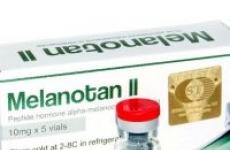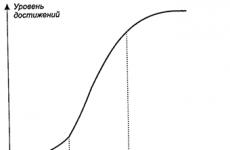Spring whitewashing of trees. Whitewashing garden trees in autumn and spring: timing, composition of solutions When is it better to whitewash fruit trees
In October, there is still a lot to do in the garden: it’s time to collect the last harvest, prepare the plants and soil for winter, and put things in order. One of the mandatory events in the garden in autumn is whitewashing trees. But many summer residents ask the question: When it's time whitewash trees in the fall? We will look for an answer to this question today.
Why whitewash?
Cleaning up your garden at the end of the season is essential to its health. Whitewashing of trees is carried out in order to destroy pests that climb under the bark in order to overwinter there. The second reason: whitened trunks suffer less from sunburn. Whitewash is applied to the trunks and bases of branches. It is believed that there is no need to whitewash young trees. Mainly whitewashing is carried out fruit trees over 3 years of age. Young seedlings are covered in a special way for the winter (but this is a topic for a separate article).
When trees are whitewashed in the fall: Timing
Some sources cite the end of leaf fall as a sign that it is time to whiten the trees. Whitewashing is best done after the rains have stopped, in dry conditions. warm weather so that the whitewash does not freeze, but dries.
Before applying lime solution or garden paint, the old bark is cleaned, root shoots cut out, dry and lifeless branches are removed, rotten fruits are eliminated from trees and from the ground.
How can you whiten trees in the fall?
We managed to find one whitewash recipe garden trees:
(source: reference book “Encyclopedia of Country Life”)
- Dissolve 2 kg of freshly slaked lime in 10 liters of water, add 500 g copper sulfate(for disinfection).
What else can you do to whiten trees?
- Lime solution with clay
- Ready-made garden whitewash, which contains chalk and binding components (sold in garden stores).
- Recipe with glue: dissolve 500 g of copper sulfate, 3 kg of quicklime and 200 g of casein glue in 10 liters of water,
- Water-based paint,
- Special garden paint (acrylic or latex).
Instead of whitewashing for the winter, tree trunks can be tied with pine branches, reeds, sunflower stems, light paper or newspapers.
What will the Lunar calendar say?
The Aif lunar calendar advises whitening fruit trees in October on the following days:
- On October 1 and 2, you can prune plants in the garden and treat them against pests,
- October 2 and 4 – favorable days for sanitary pruning of trees.
- On October 4 and 7, 11 and 13, 22 and 25, 27 and 30 October, it is recommended to clean and whiten the trunks of fruit trees.
+ spraying
In October, it is also useful to spray trees against fungal diseases and pests. To prevent scab, powdery mildew, rust and gray rot, prepare a 3-5% solution of copper sulfate. If there are lichens on the trunks, they are treated with a 3% solution iron sulfate. After harvesting and at the height of leaf fall, branches and fallen leaves are sprayed with a highly concentrated solution of urea (5%). For 1 adult tree, at least 3 liters of urea solution are consumed.
The autumn season in the garden ends by whitewashing the trees. It would seem that there is nothing simpler than this work, however, it raises many questions among gardeners, especially beginners. To which we asked candidate of biological sciences Raisa MATVEEVA to answer.
When to start autumn whitewashing? And what's the deadline?
The optimal period is from mid-October to mid-November, in dry, clear weather.
Does whitewash heal wood?
If the trunk of an adult fruit tree is “dressed” with coarsened bark with formed folds, cracks, and roughness, they can hibernate in them garden pests. In this case, whitewashing is not
It only protects the bark from sunburn, and at the same time disinfects and protects the plant from wintering pests, fungal diseases, and also fights mosses and lichens.
Is it necessary to remove old bark from a tree before whitewashing?
The trunk and main skeletal branches of the tree are conductors nutrients. They should thicken evenly and match each other. Their uniform thickening depends on the condition of the cortex. Diseased, rough bark compresses the conducting vessels and thereby prevents the supply of nutrients from the leaves to the roots and vice versa. In addition, dead bark again becomes a refuge for pests. Therefore, it and the mosses and lichens that settle on it must be removed from the tree annually using metal scrapers and wire brushes on an oilcloth previously laid under the plant. After this, all cleaning is burned, and the trunk and base of the crown are whitened.
What if the barrel is damaged? Whitewash the wound?
First, you need to heal the damage - strip it down to living tissue, disinfect it, apply garden varnish, and only then whitewash it.
Do young trees need to be whitewashed?
Undesirable: the solution clogs the pores of the bark and slows down gas exchange. For protection, including from mice and hares, overlapping spruce branches (or , roofing felt), tie tightly with twine.
Is it necessary to re-whiten trees in the spring?
In the second half of February, the amplitude of daily fluctuations in cambium temperature in trees can reach 30-40 degrees. Solar heating the trunk can provoke the beginning of bark vegetation, and night cold can cause its death. During this period, solar thermal burns may occur. To prevent damage to the bark, in the second half of February it is necessary to restore the whitewashing of the trunks and branches. This is done at a temperature not lower than -5 degrees.
4. Is it possible to whitewash wood completely? When whitewashing Special attention it is necessary to pay attention to the places where skeletal branches depart from the trunk, where pests usually overwinter and foci of fungal diseases are located. But if possible, I recommend treating the entire tree with lime mortar.
How much whitewash is needed per tree?
It all depends on the care of the gardener when applying whitewash and the age of the tree. One adult tree may need 1 kg.
What is the composition according tosquirrelsbetter?
For autumn whitewashing, as well as for February or March, the solution is prepared as follows: 2-2.2 kg of freshly slaked lime are diluted in 10 liters of water and 0.4-0.5 kg of copper sulfate, previously dissolved in water, is added. For better adhesion, add 1-2 tbsp to the lime mortar. milk.
FIRST – DISINFECTION
Before whitewashing, as a preventive measure against diseases, I treat the trees in the garden with an ash-soap infusion: I dilute 2-3 kg of ash and 50 g of laundry soap in 10 liters of hot (not boiling!) water. I dip a rag in this warm infusion and wash the trunk and branches with it. This results in disinfection and fertilization at the same time.
Vladimir BUBNOVICH, Novogrudsk
LIKE SOUR CREAM
The husband whitens trees in dry, clear weather with a solution: 2-2.5 kg of slaked lime, 250-300 g of copper sulfate, 1 kg of fatty clay, 1-2 shovels of cow manure, first diluted in a bucket with a small amount of water, and then gradually increased the volume up to 10 l. Mixes everything well. The whitewash should have the consistency of thick sour cream. If it drips when applied to the trunk, you should gradually add lime and clay, bringing the solution to the desired thickness.
Vera LIPAI, Minsk region.
NEITHER THE RAIN OR THE HARE IS AFRAID
The composition of my whitewash: for 10 liters of water - 2.5 kg of slaked lime, 1 kg of clay and 0.5 kg of copper sulfate. And so that the whitewash is not washed off by rain, I add stationery or wood glue to its composition (10% of the volume). Throwing in another handful of dried hellebore powder will help repel hares.
Alexander NIKONOV, Nizhnekamsk
To protect the garden from hares and mice, I add 1 tbsp to a bucket of whitewash. carbolic acid.
Vasily BARKOVETS, Borisov
With the onset of cold weather, when the fruit trees have already given up their harvest and shed their deciduous outfits, the garden seems to freeze, plunging into deep dream until the first spring sun rays. This period is the best time to carry out basic activities to prepare the garden for winter. Whitewashing fruit trees in the fall not only increases the yield for the next season, but also protects the garden from many troubles during the cold season.
Autumn whitewashing of fruit tree trunks performs several functions at once:
- Reflection of the sun's rays. The winter sun is deceiving. Its rays, especially during the thaw period, often cause burns on the bark of trees. Tree trunks coated with white lime are capable of reflecting Sun rays, thereby preventing overheating and cracking of the bark.
- Protection against temperature changes. Whitewash acts as a kind of thermal insulation “coat”, thanks to which the tree trunk does not overheat during the winter day and does not freeze at night. Such a “fur coat,” acting as an excellent protection for the tree from frost, prevents the formation of frost holes on the bark, which serve as an excellent environment for the development of pathogenic spores and other pathogens.
- Destruction of pathogenic microorganisms. Lime and fungicides included in the composition for whitewashing fruit trees, penetrating deeply under the bark of plants, can have a destructive effect on the colonies harmful insects and destroy microorganisms and fungal spores.
The simplest and cheap option making a whitening composition - a solution of slaked lime in the simplest white. The ratio of the components of such a solution is: 2 kg of freshly slaked lime, 300 g of copper or 500 g of iron sulfate per 10 liters of water. Adding 1 tbsp to the solution. A spoonful of carbolic acid can additionally protect trees from attacks by hares and mice.
The lime whitewash solution is stirred in a bucket until it has the consistency of thick sour cream.
Many gardeners have been using this solution since time immemorial. Although the degree of protection of such whitewash is not high enough, thanks to affordable price and ease of manufacture, it remains one of the most popular among most gardeners.
In the absence of the opportunity to treat the surface of the trunk with a whitening compound, you can always use another old-fashioned method - coat the trunks with a regular mixture of clay and mullein. To do this, you need to mix 2 kg of lime, 1 kg of clay, 1 kg of cow dung and 250 g of copper sulfate in a container.
Option #2 – ready-made garden mixtures
Garden mixtures based on lime and clay allow the tree to “breathe”.
If lime mortars can be applied only to mature trees, clay mixtures can also be applied to young seedlings without harming growth
The only drawback of this solution is that during the winter it is gradually washed off from the trunk. That's why in early spring It is advisable to carry out whitewashing of fruit trees again.
Option #3 – acrylic and water-based paints
Acrylic paint, which contains antifungal and bactericidal components, effectively protects tree trunks from any pathogens.
Such whitewashing is good if the owner does not have the opportunity to promptly check the condition of the tree trunk: whether the protective paint remains on them after winter
Advice. Acrylic whitewash is not a “breathable” base and therefore it is not advisable to use it on young seedlings.
Water-based paint is effective in combating winter frosts, but it is not able to protect the tree from harmful insects. Therefore, before using it, copper-containing components are added to the paint composition.
Rules for whitewashing work
You can start whitewashing trees in the second half of autumn, when the rainy season has already passed and the air temperature has settled around 2-3 °C. It is better to choose a fine, dry day for whitewashing.
Whitewashing can only be done on trees that have entered the fruiting season. Young seedlings purchased in the autumn season are not whitened for the winter, since the protective paint only clogs the pores of the tree and does not allow the plant to fully develop, leading to its death.
One or two year old seedlings are simply tied with any covering material. Agrofibre is best suited for these purposes.
Polyethylene film is far from the best choice, since by retaining moisture, it provokes development on sheltered area trunk mold and fungi.
Preparatory work
Before whitewashing, it is necessary to carefully inspect the trees to eliminate breeding grounds for pathogens. Tree trunks and the lower bases of skeletal branches need to be cleared of dried and diseased bark, old growths and moss. Although lichens do not harm the bark of trees, they clog them. You can get rid of lichens by “washing” the trunks with a solution consisting of 1 kg of salt, 2.5 kg of ash and 2 pieces of laundry soap. All components must be mixed and poured into 1 bucket hot water, bring to a boil and cool.
The trunk can be cleaned with wooden spatulas, metal scrapers or brushes, or use serrated saws for this.
You need to work with tools very carefully so as not to damage the plant bark. After cleaning, all wounds and damage must be treated with garden varnish.
If you don’t have garden varnish on hand, you can make your own wound-healing putty. To do this, you need to mix 2 parts clay with 1 part manure, adding copper sulfate and straw dust to the mixture. The putty should be as thick as sour cream.
Carrying out whitewashing of trunks
You can whitewash trees using either a regular brush or a spray gun. However, when working with this convenient device you should be prepared for the fact that paint consumption will be an order of magnitude higher compared to traditional way whitewashing To make painting easier, it is advisable to prepare brushes in advance that match the thickness of the trunk and skeletal branches.
Whitewashing should be done starting from the bottom of the trunk and gradually rising to the skeletal branches. The height of whitewashing skeletal branches should be 20-30 cm from the branching point
Tree trunks covered with snow-white paint give the garden a special, festive look. But it is not difficult to guess that gardeners so carefully restore the whiteness of their trunks not at all out of a desire to give the trees Beautiful design. Whitewashing of trees in autumn and spring is done to protect against burns from ultraviolet rays. It makes sense to figure out exactly when to carry out such work and what working solutions are best to use.
Why are trees whitewashed?
Bark is for a tree what skin is for a person; it is intended to protect a living organism from the sun and wind, temperature changes, bright sunlight and rodent teeth. Exposure to natural factors leads to the fact that over time it becomes rough, cracks and peels off. Her protective functions At the same time, they will decrease and the entire plant will suffer. It is easy to assume that the cortex, as a protective organ, itself needs some protection.
Whitewashing will help ensure it, which will protect:
- from sunburn in spring and in the second half of winter, the sun at this time is already quite bright, due to the lack of leaves, the rays have direct access to the trunk
- from exposure sudden change temperatures, in the off-season, during the day it can change by ten degrees, which negatively affects the condition of the bark, causing cracks to appear
- from damage caused by insects
- from frostbites
The whitewashing procedure should be taken responsibly; it is recommended to whitewash all trees, regardless of whether they are garden or decorative.
Whitewashing trees in autumn, deadlines for completing the work
According to experienced gardeners, it is advisable to carry out the treatment two or even three times a year: in the fall, in the summer, and at the beginning of spring. The main thing is considered to be autumn whitewashing. Best time- before the start of frost, in the last ten days of October.
Autumn whitewashing will provide:
- protection against fungal infections and pests that have penetrated into the cracks of the bark
- will prevent the formation of ice on it
- to some extent it will scare away hungry hares - they are unlikely to like gnawing the lime coating.
If for some reason it was not possible to whitewash the trees in the fall, you will have to do it in February. It is during this period that dangerous situation- heating unbleached bark to +11 C leads to awakening of sap flow, but at night the temperature can drop to - 10 C, creating a threat of freezing of the trunk. During the crystallization process, the sap can tear apart the wood tissue. As a result, frost holes are formed, which are deeply cracked bark.

The whitened surface actively reflects the rays, the surface of the bark warms up much more slowly, the awakening of the tree begins only with the onset of real warmth, when the threat of severe night frosts practically disappears.
Even in case of timely autumn processing, you cannot refuse to repeat the procedure in the last days of March.
In summer, whitewashing should be repeated only if the paint has been washed off by rainfall. In case of use leave-in composition Summer wood processing can be abandoned. It is recommended to choose a quiet, sunny day for work.
What is the best way to whitewash (paint) trees?
The following can be used as whitewashing material:
- lime or chalk mortars
- water-based or water-dispersed garden paint
If you prepare the solution yourself, then it should include three components:
- slaked lime
- clay, wood glue
- disinfectant, copper sulfate is quite acceptable

The most common option is to use lime mortar; it is washed off quickly, and the protection it provides is not very reliable, but it is attractive because it is cheap and easy to prepare.
lime for whitewashing trees
For self-cooking you will need slaked lime or chalk, at the rate of two to three kilograms per 10-liter bucket of water. You will also need flour paste or casein glue, about 100 g, about half a kilogram of copper sulfate. Stir the solution until a homogeneous mass is obtained, then infuse for several hours.

You can also use another recipe, prepare:
- bucket of water 10 l
- 1 kg lime
- 1 kg manure
- 0.2 kg copper sulfate
All components are mixed and left for a couple of hours.
A composition with casein glue will stay on the bark for a longer time. To obtain a working solution, mix 2 kg of lime with 400 g of copper sulfate and 100 g of glue. Then pour warm water and insist.

You can replace the glue with fatty white clay; you will need 1 kg of it per bucket of water.
paint for whitewashing trees
The best option for whitewashing material is garden water-based paint, it creates a moisture-resistant layer that is impenetrable to sunlight. But it does not clog the pores of the wood, i.e. is vapor permeable.

In addition to the color pigment, the paint contains latex, antiseptic substances and modifiers.
Some of the benefits of garden paint include:
- ability to block ultraviolet radiation
- breathability
- ability to stay on the bark for a long time, about 2 years
Whitewashing of trees with water-based garden paint is carried out at a temperature not lower than +3 +4 C, it is advisable to apply the paint in two layers.
You can make whitewash paint yourself, but in this case you will need to purchase bustylate glue or any other latex-based glue. To one part of the coloring pigment (chalk or white clay) add two parts of glue. The components are mixed, then water is gradually added until the consistency inherent in oil paints is obtained.
Whitewashing trees with fluff and garden paint - what tools and equipment can be used for the job
The traditional tool for applying whitewash to bark is a scourer brush, but in today's market construction tools A lot of easy-to-use products have appeared, these are:
- paint brushes, flat, made of artificial bristles,
- maklovitsa
- flute brushes

Such tools are convenient; thanks to the long bristles, paint is equally easily applied to smooth and rough surfaces. Some gardeners even use paint rollers for their work - it turns out well.

If there are many trees and they are large enough, then the best option will use a spray gun.
Trees should be whitewashed to a sufficiently high height - about 1.8 -2 m, i.e. Not only the trunks, but also about a third of the length of the skeletal branches should be coated with paint.

The whitewashing process must be preceded by proper preparation tree for this procedure. Having chosen a damp day, you should start cleaning the bark of the trunk and branches from moss, lichens and flaking pieces of bark. It is not recommended to use any rough tools in this case - there is a risk of damaging the good young bark.
You should work wearing thick gloves. You can use a wooden knife or a sharp peg to clean the recesses. It is recommended to burn the removed bark fragments.
On a sunny, dry day, when there is no sign of precipitation, disinfection should be carried out.

To do this they breed:
- three percent solution of copper sulfate
- you can use the drugs Oksikhom, HOM
- Bordeaux liquid.
The treatment should be carried out using a fine spray; it is best if the solution falls on the surface of the bark in the form of a mist; it should not be allowed to flow down the bark.
It is not recommended to use copper-containing preparations annually. Copper, accumulating in the bark, can have Negative influence on the plant itself, it will weaken. Treatment with fungicides should be alternated with soap-ash solutions. They perfectly disinfect the surface of the bark and are beneficial for plants in themselves.
Solution with soap and ash It's very easy to cook. Grate a bar of laundry soap, weigh out 100 g. 6 kg of wood ash are sifted to separate specks, pour everything into 20 liter capacity, poured hot water. After mixing the contents, let it brew and cool.

Processing the bark will be useful lye ash. To make it, take purified wood ash, pour water 1:4, heat to a boil. Then cool and filter. Before treating trees, dilute with water. You can generously spray the bark with this solution, or even wash it.
To heal wounds on the bark, homemade and ready-made compositions are used. Most often it is a mash of clay and water; copper sulfate can be added to it to impart disinfecting properties; finely chopped straw can be added to it for strength. The resulting mixture should have the consistency of sour cream.

The second, no less popular remedy is garden var. It is sold in finished form in gardening stores.
But if you wish, you can make it yourself: melt rosin and add beeswax and pork fat. When all components are mixed until smooth, pour into a container with cold water. After cooling partially, roll into balls. Before using the varnish, it should be heated, it will acquire elasticity.
IN trading network also available garden paste rannet, enriched with copper sulfate and humate. Since the paste is not resistant to moisture, it is used in good weather.

Having prepared the trees accordingly, they begin whitewashing. If you need to whitewash trees so that they do not wash off, use garden paints; if it is possible to repeat the procedure several times a year, use lime or chalk mortars.
You can often hear the opinion that only large trees should be whitened, and young seedlings do not require treatment, because lime can burn their bark. But experienced gardeners They say that if there are concerns about lime, then you should use paint - it will not cause harm. If you use diluted lime, the concentration of the mixture should be reduced by half.

Sunburns caused by young trees can be much more dangerous than those caused by lime.
If we talk about how to dilute whitewash for trees, then it should be noted that you will need to achieve a uniform consistency, equal in thickness to sour cream; the presence of lumps of glue or lime is undesirable. The color of the resulting coating should be white - gray will not adequately repel the sun's rays. You can evaluate whiteness only after the paint has completely dried - when wet it always has a grayish tint.
There is no need to spare the whitewash solution; it is generally recommended to spray the excess around the tree.
A more sustainable effect can be achieved using garden paints; whitewashing will have to be repeated more often when using a solution of lime and chalk.

When making homemade solutions, you can add white clay to them as an adhesive, laundry soap, manure or copper sulfate as an antiseptic.
Practice shows that systematic whitewashing fruit trees gives the garden more decorative look, reduces the level of disease in trees, helps to increase productivity, which is quite natural - a healthy tree bears fruit better. But the most important thing is that well-groomed trees live much longer.
When to whitewash trees? Definitely in the fall in October-November, in slightly cloudy but dry weather! You can renew the whitewash in February-March with the same composition. Whitewashing will protect trees from sunburn, which occurs not only in spring, but even in winter. Moreover, trees need to be whitened at above-zero temperatures (+5°C), which is impossible in early spring.

About whitewashing trees
Young trees do not have to be completely whitened, just before they branch out! Since the branches of the crown do not get much direct sun, and there is a shadow from each other.
- How to whiten trees faster? Tie several flat brushes into one large one, it will whiten faster and absorb better. Do not spare the solution. Sprinkle the rest over trunk circle. Remember that trees will not acquire a bright white color immediately after whitewashing, only after a few hours.
- How to whitewash trees? We can advise you right away acrylic paint, since it is the most resistant to rain, i.e. will not blur, and it will retain its reflective properties in good condition until spring. Of course, you can choose well-known clay and lime mortars, but in this case re-processing definitely cannot be avoided. It is better to whiten young trees with just such solutions so that the bark can breathe.
To whitewash trees, you can combine substances such as lime or chalk with PVA, milk, clay or even laundry soap and add manure or copper sulfate as a disinfectant.
 Examples of whitewash solution for lime trees
Examples of whitewash solution for lime trees
- 1 kg of manure, 1 kg of lime, 200 grams of copper sulfate and pour all this into 8 liters of water. Mix thoroughly and allow the components to dissolve completely for 2-3 hours. The whitened part of the trees will be slightly bluish due to the addition of vitriol.
- 1 kg of fatty clay, 2 kg of slaked lime, 1 shovel of cow dung, 250 grams of copper sulfate per 10 liters of water. Mix everything and let it brew for several hours.
- 2 kg of slaked lime, 400 g of copper sulfate (dissolved in hot water), 50-100 g of casein glue per 10 liters of water. This recipe will have greater strength and durability.
 Note to summer residents:
Note to summer residents:
- pay attention to the consistency of the whitewash; there should be no lumps when applied and it should not flow on the wood (the consistency of thick sour cream). The thickness of the whitewash is 2-3 mm, which means that, most likely, whitewash from slaked lime will have to be applied to the trees several times;
- the color when dried should be white, not gray, only White color repels the sun's rays;
- It is necessary to add adhesive components so that rain cannot wash off the whitewash from the trees;
- Young trees need to be whitened with a lower concentration of lime, so for them, dilute lime with 20 liters of water;
- If the whitewash falls off the bark, then the tree will have to be whitewashed.
How to prepare trees for autumn whitewashing
Whitewashing trees is simply necessary. However, for whitewashing to have the desired effect, the trees need to be prepared.
If trees are whitewashed in dry weather, then they begin to prepare the trees for whitewashing in wet weather. It is important!  Place a tarpaulin or durable film under the tree, where the “bad” bark will fall. You need to clean the trunk and skeletal branches of mature trees from dead bark, lichens, etc. It is better to do this manually, wearing gloves, without using metal scrapers and brushes, so as not to accidentally injure healthy wood. Clean out grooves and dimples wooden knife or a sharp stick. Now you need to burn everything scraped and it is better to do this not on the site, since the peeled bark contains pests and pathogens.
Place a tarpaulin or durable film under the tree, where the “bad” bark will fall. You need to clean the trunk and skeletal branches of mature trees from dead bark, lichens, etc. It is better to do this manually, wearing gloves, without using metal scrapers and brushes, so as not to accidentally injure healthy wood. Clean out grooves and dimples wooden knife or a sharp stick. Now you need to burn everything scraped and it is better to do this not on the site, since the peeled bark contains pests and pathogens.
After such manual cleaning in wet weather, it is necessary to disinfect the bark, but only in stable dry weather. Make a solution: 300-500 grams of copper sulfate with Bordeaux mixture or HOM preparation per bucket of water. Spray the trees using a fine mist method so that the droplets create a mist and settle on the bark rather than running off in a stream. There is another treatment option - a solution of iron sulfate with a copper-containing preparation (600-800 grams of iron sulfate per 10 liters of water). However, it is not recommended to use this solution every year, since copper and iron in high concentrations become poisonous and the plants begin to become weak!
It is best to use an ash-soap solution:
- For 1 liter of hot water, 5 grams of laundry soap and 200-300 grams of ash.
- Soak a rag in this solution and wash the trees. The ash will both disinfect and fertilize.
- OR 2-3 kg of sifted ash for 10 liters of water, stir for 15-20 minutes, put on fire and bring to a boil.
- Dilute the cooled and settled liquid with water 1:1 and spray the trees or 1:2 and wash the trees.
The next stage in preparing trees for whitewashing is sealing the wounds. Here you can use any putty, purchased or made by yourself.
For example:


- Garden pitch – 200 gr beeswax and melt 100 grams of rosin separately over low heat. Combine, add 100 grams of unsalted fat and wait until the fat melts. Next, pour the mixture into cold water, take out what you get and make a lump. Covering with garden varnish is very convenient; the main thing is to warm it up before use, then it will become a plastic mass.
- Clay mash is an excellent putty for sealing wounds on trees. Take 200 grams of clay, 100 grams of cow dung and a bit of finely chopped straw, diluted in water to the consistency of thick sour cream.
The final stage of working with trees in the fall is directly whitewashing the trees.
Autumn is the time when it would be blasphemy to ignore this process.






